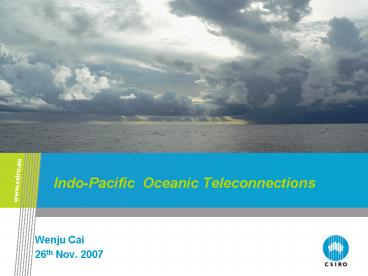IndoPacific Oceanic Teleconnections PowerPoint PPT Presentation
1 / 19
Title: IndoPacific Oceanic Teleconnections
1
Indo-Pacific Oceanic Teleconnections
- Wenju Cai
- 26th Nov. 2007
2
A schematic of the Indo-Pacific mean circulation
3
Why study the Indo-Pacific oceanic teleconnection?
- Indo-Pacific variability influences rainfall
variations, rainfall prediction and future
rainfall projections. - Multi-decadal Pacific variability could
pre-condition the IO thermocline, whereby
influencing the frequency and amplitude of IODs. - Unless interannual Indo-Pacific teleconnection is
well simulated, model IODs and their influence on
rainfall tend to be unrealistic. - Attribution of climate change requires a
quantification of the importance of the
inter-basin exchanges.
4
Outlines
- How ENSO discharge recharge signals transmit to
the Indian Ocean? What are pathways - Observed multidecadal variability of the
transmission - What controls the transmission properties using
IPCC AR4 models - Conclusions
5
Transmission through the Equatorial Pacific (EP)
pathway
WA
Clark, JGR, 1991 Potemra et al., JPO, 2002
Wifffels and Meyers, JPO, 2004
6
Transmission through the off-equatorial North
Pacific (NP) pathway
Munk-Kelvin Waves
larger f, small velocity
Div.
Conv.
L
Deepened
Shallow
Equator
Godfrey, JPO, 1975 McCreary, Mon. Wea. Rev.
1983 Cai et al. 2005
7
The transmission to WA involves both pathways
and is strong since 1980
Post-1980
Pre-1980
Before 1980, little is transmitted
Before 1980, ENSOs are week and more
equatorially confined
Jin 1997 Meinen McPhaden 2000
8
Two controlling factors
- Meridional extent of ENSO
- Amplitude of ENSO
9
post-1980 wide meridional extent of ENSO
anomalies ? NP Rossby waves are involved.
Pre-1980
Post-1980
10
The strong ENSO discharge to the Indian Ocean
temperature change
Shi, Ribbe, Cai, and Cowan, GRL, 2007
11
Weak ENSO ? Low ENSO Signal/Noise Ratio D20
Signal One standard deviation associated with
Nino3.4
Noise One stand deviation after removing ENSO
12
CSIRO Mk3.5 multi-century control Exp. outputs
Fluctuation in the ENSO amplitude 30-year window
Fluctuation in the transmission of ENSO signals
to WA 30-year window
13
IPCC AR4 22 models. 4 failed 1 to WA Sumatra
1 to Sumatra
Cor Thermocline Nino3.4 Lag. 3
14
IPCC 22 AR4 models 8 simulate transmission via
EP NP pathway 8 simulate transmission via EP
only
EP only
NPEP
15
Dependence on the strength of ENSO signal
Lag 3 Nino3.4 and WA heat content
16
Dependence on signal to noise ratio
Lag 3 Nino3.4 and WA heat content
Heat content signal/noise ratio at WA
17
Dependence on the meridional extent of ENSO
anomaly
18
Conclusions
- Transmission of ENSO signals involves two
pathways EP and NP. - Broader, stronger ENSOs tend to involve NP Rossby
waves, hence signals are transmitted via NP
pathway. - Stronger ENSOs have a greater signal to noise
ratio, more detectable. - These properties are reflected in the inter-model
variations of the IPCC AR4. - AR4 models simulate a cold tongue that is too
narrow, underestimating the importance of the NP
pathway.
19
Thank You

